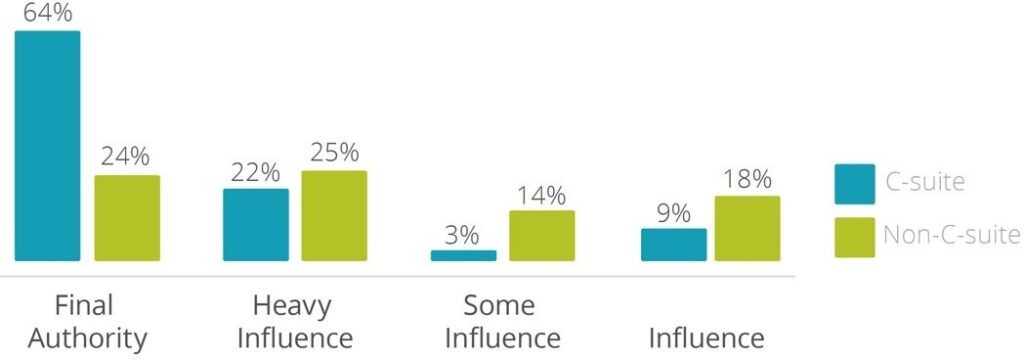“What are your intentions with my daughter?”
As a sitcom joke, this line is obviously outdated – but think about it from a B2B marketing perspective.
“What are your intentions with my website?”
When someone visits your website, wouldn’t it be great to know exactly why they’re there?
Specifically, wouldn’t you love to know which leads are ready to buy – right now?
According to Marketing Profs, companies with an account-based marketing strategy generate 208% more revenue than those that don’t – but you need the right kind of data to deliver successful results.
If you’re wondering “what is intent data,” that’s the gist of it: understanding why someone has visited your website. Here’s why it’s important and how you can use it to fuel your B2B marketing strategy
What is Intent Data?
Using information about a visitor’s online behavior, intent data tells you their stage of the sales funnel.
Think about how you conduct online searches and how Google guides your search:
- You type “sore knee after running” into Google and browse some of the links.
- After learning about common running-related knee conditions, you type the letter R into the search bar and Google prompts you to finish a search for “runner’s knee.”
- You return to the search bar and type “il” and Google assumes you’re typing “iliotibial band syndrome.”
- After learning about IT band syndrome, you go back to the search bar and type “IT band” and Google already knows that you’re looking for “IT band syndrome treatments.”
From here, you can see why this prior search history and other information like age and gender may be useful for a physical therapy office. They can understand your intention – that you’re seeking treatment from running-associated knee pain – while running PPC ads and providing personalized content on their website.
However, that’s B2C. What is intent data in a B2B context?
Topic Data
Intent data involves two components: behavioral data and context.
When someone visits your website, you may not think you know much about them, but other websites do. Using topic data, you can figure out:
- Which website they visited before arriving at yours.
- How long they spent reading about specific topics.
- Which other topics they’ve recently researched.
Context Data
Context data supplies background to your behavioral data which may include:
- The company a visitor works for.
- How long they’ve worked there.
- A visitor’s job role and buying power.
It’s easy to see how combining behavioral and context data can help you identify a lead’s stage – and role – in the buying cycle.
Where Does Intent Data Come From?
Intent data can either be anonymous or known. It can come from either first-party sources (your website and lead magnets) or third-party sources (other websites, social media, other email lists, and other websites’ lead forms).
- Anonymous Intent Data: You have an IP address and other information based on it (like Google search history and company name) but not a name or face.
- Known Intent Data: You know more personal details about a visitor based on information from sources like forms.
Why is Intent Data Important?
Intent data sounds cool, but why does it matter? Is it worth the time and effort?
Yes. Here’s why.
It’s Useful for Personalization
65% of businesses say they’d have no problem switching vendors if a company does not provide personalized content.
That’s a lot of lost revenue.
With intent data, you can gain a better understanding of your leads and website visitors so you can create personalized content for leads at every stage of the buying cycle.
It’s Hyper-Relevant
Intent data doesn’t just give you information about website visitors – it puts that data into context.
Context is especially useful when the time comes to run personalized email campaigns and retargeting ads on social media.
It Saves You Time and Money
You’ll know which leads are ready to buy, which aren’t quite decision-makers, and which are just browsing so you’ll be able to laser focus your marketing efforts.
Every dollar will stretch much farther when you know the buyer intent of each lead.
It’s More Accurate than Predictive Analytics
Predictive analytics are useful, but they’re often delayed. Intent data is based on real-time behavior and information so it’s the most correct and up-to-date data available.
What is Intent Data Useful For?
Here are a few ways you can incorporate intent data into your overall B2B personalization strategy.
Creating Effective Account-Based Marketing Strategies
If you’re only targeting senior-level executives, you’re missing out.
According to research from Think with Google, while 64% of senior execs have the final say, non-C suite members still have a massive influence in the buying process.
Intent data can help you identify how much influence each visitor has, which role they play, where they’re at in the buying stage, and which other competitors they’ve researched.

Source: Think with Google
Personalize Your Website’s Experience for Everyone
With features from Hushly like content bingeing, adaptive content hubs, and self-nurturing landing pages, you can use intent data to personalize content – even for anonymous visitors.
Filtering Your Audience List by Engagement
Since intent data happens in real-time, you’ll be able to score leads more effectively and offer them the most relevant content at any given moment.
Running Successful Retargeting Campaigns
Retargeting ads through email marketing and social media can play an extremely useful role in your B2B marketing strategy, but if it’s not hyper-personalized, it won’t deliver results you want. Intent data can optimize your retargeting game.
Improve Your Personalization Strategy Now
Hushly can help you create a personalized experience for every website visitor. Using data-driven technology, you can create adaptive content hubs and self-nurturing landing pages with content bingeing features that allow your leads to educate themselves at their own pace – perfect for account-based marketing.
Best of all, Hushly uses human verification to make sure all of your leads are not only real people but also real B2B buyers by cross-referencing LinkedIn information. You only pay us for real leads, not using the platform. Check out the demo now!



